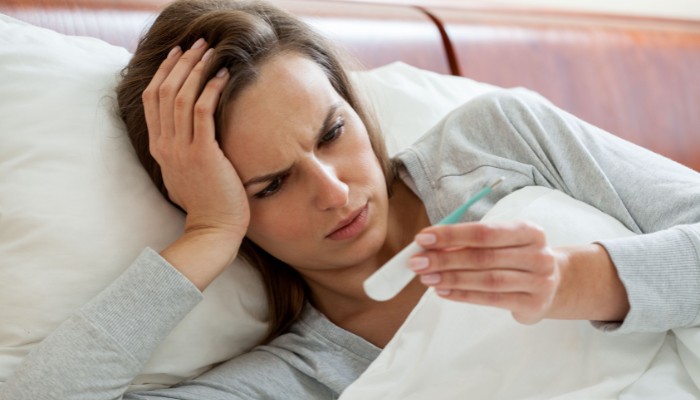Despite fever not being directly caused by ovulation, the immune system experiences a slight decline during this process, potentially increasing the likelihood of infection from viruses and other germs.
While a slight rise in basal body temperature is to be expected around the time of ovulation, a fever is usually unrelated.
According to Medical News Today:
“During the luteal phase, estrogen levels drop and progesterone levels rise. This allows the body to prepare for the presence of a developing fetus.
It also means that a person’s immune system function decreases during this phase.”
This explains why you might be more prone to getting sick or developing an infection around the time of ovulation, thus the feverish feeling.
Table of Contents
Feverish During Ovulation
Personally, I don’t feel feverish every month when I ovulate, but it has happened on occasion, and I wondered if the two events were related.
After much research and a talk with my OB/GYN, I discovered that I was likely fighting a mild infection and that it was just a coincidence that ovulation occurred at the same time.
Here’s what I learned:
Flu-Like Symptoms During Ovulation
It is surprisingly common for women to feel cold or flu-like symptoms at the end of their menstrual cycle between ovulation and the start of their next period.
This is sometimes referred to as the “period cold” or “period flu.”
Symptoms of the period cold include nausea, body aches, fatigue, dizziness, diarrhea, backaches, headaches, and even a low-grade fever.
While the period cold is common, it does not usually happen every time you ovulate.
Symptoms such as a runny nose, sore throat, cough, or fever are typically caused by germs, not ovulation.
A urinary tract infection or other infection within the body could also cause you to feel unwell and run a low-grade fever.
What Is Considered a Fever in Adults?
An adult likely has a fever when the body temperature is above 99℉, but medical providers usually only consider temperatures over 100.4℉ to be fevers.
A low-grade fever is between 100 and 102℉. Anything above that is considered a high-grade fever.
Low-Grade Fever During Ovulation
A low-grade fever during ovulation is not a typical symptom associated with the ovulatory phase of the menstrual cycle.
However, there are several reasons why someone might experience a low-grade fever or feel warmer during ovulation:
- An underlying infection or illness could be responsible for an elevated temperature during ovulation.
- Inflammation in the pelvic region, unrelated to the reproductive system, could also potentially cause a mild increase in body temperature.
- Emotional stress or anxiety can sometimes manifest physically, and an increase in body temperature might be a response to heightened stress levels.
High Temperature During Ovulation
If your temperature exceeds 99℉, it is not just your BBT rising. You likely have an actual fever.
It is possible to spike an actual fever during ovulation as well as experience flu-like symptoms, not just because of ovulation but because of germs.
It might be a good idea to increase your vitamin C intake during ovulation.
Research has discovered a possible link between ovulation and the female immune system, which could be the reason for actual fevers or flu-like symptoms during ovulation.
When a woman is ovulating, her body is readying itself for fertilization.
At this stage, estrogen levels rise, and a number of changes occur to make fertilization more likely, including lowering immune system function to prevent the immune system from attacking sperm.
Estrogen lowers the activity of molecules in the immune system that defend you against viruses, pathogens, and other bacteria.
Because of this, you are more likely to become infected by such pathogens during ovulation.
How To Treat a Low-Grade Fever During Ovulation
If you experience a low-grade fever during ovulation or at any other time, the appropriate treatment will depend on the underlying cause of the fever.
However, there are some general care tips that might help alleviate your discomfort:
- Drink plenty of fluids, such as water, herbal teas, and clear broths, to stay hydrated. Hydration is essential for supporting the body’s immune function.
- Get adequate rest to allow your body to recover. Avoid strenuous activities, and give yourself time to recuperate.
- Acetaminophen (Tylenol) or ibuprofen (Advil, Motrin) can help reduce fever and relieve discomfort. Follow the recommended dosage, and consult with your doctor, especially concerning underlying health conditions and potential interactions with other medications.
- Applying cool compresses to the forehead or the back of the neck can help bring down body temperature and provide relief.
- Wear lightweight and comfortable clothing to help regulate body temperature.
- Take a lukewarm bath or shower to cool the body gradually.
If the fever is persistent or accompanied by other concerning symptoms, it’s important to consult with your healthcare provider.
The fever could be a sign of an underlying infection or other medical condition that requires specific treatment.
Basal Body Temperature When Ovulating
It is normal to experience a slight temperature rise during ovulation but not to the point of having a fever.
The basal body temperature is a person’s normal, resting temperature. For most women, this temperature averages between 97℉ and 97.5℉.
Just before you ovulate, your body temperature will dip slightly.
Then, 24 hours after the egg is released, your BBT rises about one degree and stays elevated for several days.
Some women may be more sensitive to this slight rise in temperature and feel feverish or overheated during and after ovulation.
How Much Should Temp Rise After Ovulation?
Your temperature should only rise about one degree after ovulation.
On average, a normal BBT is between 97℉ and 97.5℉. After ovulation, it rises between 97.6℉ and 98.6℉.
The numbers in this range are relative and could be slightly different for each woman.
However, your temp should not increase more than one degree above your normal BBT.
If it does, you likely have a fever caused by pathogens or other bacteria.
How Long After Ovulation Does BBT Rise?
BBT rises 24 hours after an egg is released and may stay elevated for several days.
The normal luteal phase after ovulation is 11-14 days, and the temperature should stay elevated until menstruation.
Basal Body Temperature if You Conceive
If you do not conceive, your BBT will drop with menstruation.
An elevated BBT that lasts for 18 or more days following ovulation may be an early indicator of pregnancy.
This is because of the continued presence of the hormone progesterone, which helps implantation and supports pregnancy.
Common Symptoms of Ovulation
Fevers and flu-like symptoms do happen, but they are not the most common symptoms of ovulation.
If you are tracking your menstrual cycle, look out for these symptoms as indicators that ovulation is near:
- Menstrual-like cramping on the side of the abdomen near the ovaries
- Changes in cervical mucus
- Increased libido
- Mood swings
- Appetite changes
- Gassiness
- Tender or full breasts
- Bloating
- Nausea
- Fluid retention
- Light spotting
- Being lightheaded or dizzy
- Increased urination
Not Feeling Well During Ovulation
A woman will often not feel her best during her period or during ovulation.
Hormonal changes that occur throughout the menstrual cycle can cause a variety of unpleasant physical symptoms.
You may experience cramps, mild pain, discomfort, nausea, or fatigue, or you may just feel “blah” during ovulation. All of these are totally normal.
If you find yourself not feeling 100% during ovulation, take it easy, and be sure to rest. Focus on maintaining a healthy diet and staying hydrated.
Get some fresh air or sit in front of a cool fan. If you are able, take the time to pamper yourself or indulge in a lazy day at home.

Tracking Ovulation
Tracking ovulation is important for individuals who are trying to conceive or who want to understand their menstrual cycle better.
There are several methods available for tracking ovulation, each with its own advantages and limitations:
Calendar Method
This method involves tracking your menstrual cycle on a calendar over several months to identify patterns and predict when ovulation is likely to occur.
It’s based on the assumption that ovulation usually occurs around the middle of the menstrual cycle.
This method is less accurate than others and may not be suitable for individuals with irregular cycles.
Basal Body Temperature (BBT) Charting
BBT charting involves taking your basal body temperature (resting temperature) every morning before getting out of bed.
A slight increase in temperature (usually about 0.5 to 1 degree Fahrenheit) indicates that ovulation has occurred.
BBT charting is more effective when used in conjunction with other methods, as it only confirms ovulation after it has happened.
Ovulation Predictor Kits (OPKs)
OPKs detect the surge in luteinizing hormone (LH) that occurs just before ovulation.
LH surge indicates that an egg is about to be released from the ovary.
These kits are available over the counter and are convenient for at-home use.
Cervical Mucus Monitoring
Cervical mucus changes throughout the menstrual cycle, becoming clear, slippery, and stretchy around ovulation.
Monitoring changes in cervical mucus consistency and appearance can help predict when ovulation is likely.
Fertility Awareness-Based Methods (FAMs)
FAMs involve combining various methods, such as tracking basal body temperature, cervical mucus, and calendar calculations, to estimate fertile days.
This method requires consistent and careful tracking of multiple indicators.
Smartphone Apps
Many smartphone apps are designed to help individuals track their menstrual cycles, predict ovulation, and identify fertile days.
These apps often use a combination of data input (such as BBT, menstrual cycle length, and symptoms) to make predictions.
Hormonal Monitoring Devices
Some modern devices, like fertility monitors, use advanced technology to track hormonal changes related to the menstrual cycle.
These devices may measure hormones such as estrogen and LH to predict ovulation.
How a Fever Can Impact Your Ability To Conceive
A low-grade fever is generally not considered a major obstacle to conception, and many women may conceive despite experiencing mild fluctuations in body temperature.
However, a fever can potentially impact the fertility process.
If a fever is associated with an illness or infection, it can affect the menstrual cycle and potentially disrupt the timing of ovulation.
This might make it more challenging to accurately predict fertile days for conception.
Elevated body temperature, even if it’s just a low-grade fever, can affect sperm quality and motility.
Fever or illness can also impact the consistency and quantity of cervical mucus, which can affect sperm transport and viability.
Illness-related factors, such as stress and hormonal changes associated with fever, can contribute to irregularities in the menstrual cycle, affecting the timing of ovulation and the overall fertility window.
Chronic or recurrent illnesses that lead to persistent low-grade fever might have broader implications for overall health and well-being, potentially impacting fertility in the long term.
Mom of three (including identical twin boys), wife, and owner of Parents Wonder. This is my place to share my journey as a mother and the helpful insights I learn along the way.

